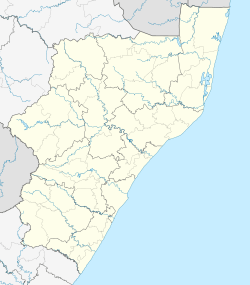Ixopo
| Ixopo Stuartstown | |
|---|---|
|
SAR Class NG G11 no. NG55 arriving at Ixopo station | |
 Ixopo  Ixopo Ixopo (South Africa)  Ixopo Ixopo (Africa) | |
| Coordinates: 30°09′26″S 30°03′53″E / 30.15722°S 30.06472°ECoordinates: 30°09′26″S 30°03′53″E / 30.15722°S 30.06472°E | |
| Country | South Africa |
| Province | KwaZulu-Natal |
| District | Harry Gwala |
| Municipality | Ubuhlebezwe |
| Area[1] | |
| • Total | 10.85 km2 (4.19 sq mi) |
| Population (2011)[1] | |
| • Total | 12,461 |
| • Density | 1,100/km2 (3,000/sq mi) |
| Racial makeup (2011)[1] | |
| • Black African | 90.6% |
| • Coloured | 5.6% |
| • Indian/Asian | 1.9% |
| • White | 1.4% |
| • Other | 0.5% |
| First languages (2011)[1] | |
| • Zulu | 74.8% |
| • English | 10.6% |
| • Xhosa | 7.6% |
| • Sotho | 2.2% |
| • Other | 4.8% |
| Time zone | UTC+2 (SAST) |
| Postal code (street) | 3276 |
| PO box | 3276 |
| Area code | 039 |
Ixopo is a town situated on a tributary of the Mkhomazi River along the R56 highway in the midlands of KwaZulu-Natal, South Africa and forms part of an important sugar farming, and forestry area.
Background
Ixopo was formerly known as Stuartstown, was laid out in 1878 and named after M Stuart, Resident Magistrate of the Ixopo district, who was killed at the Battle of Ingogo in 1881.[2][3]:256 Its name is derived from the Zulu onomatopoeic word, eXobo, describing the sound made as cattle squelch through mud.[3]:256 The 'x', in Zulu, is pronounced as a lateral click).
Ixopo is most famously described by Alan Paton in the opening lines of Cry, The Beloved Country: "There is a lovely road which runs from Ixopo into the hills. These hills are grass covered and rolling, and they are lovely beyond any singing of it."[3]:256
The town houses two schools including a high school with a large proportion of boarding pupils who live in surrounding villages (such as Bulwer, Underberg, Creighton) which are too small to justify the erection and staffing of a high school.
In the 1990s, before South Africa became completely democratic, Ixopo was the centre of a number of armed clashes between two political parties, the African National Congress and the Inkatha Freedom Party.
The Buddhist Retreat Centre, one of South Africa's major Buddhist centres is in Ixopo.
Until the mid-1980s, Ixopo was served by a railway station on the 610 mm (2 ft 0 in) narrow gauge Umzinto - Donnybrook narrow gauge railway.[3]:256
Patons Country Narrow Gauge Railway
In 2000 the former branch of the Umzinto - Donnybrook railway from Ixopo to Umzinkulu (Madonela) was reconstructed by Patons Country Narrow Gauge Railway (PCNGR).
As the line was partially lifted after closure in the 1980s, the track was in need of a complete rebuild.
PCNGR established its headquarters and northern terminus at Allwoodburn, formerly the livestock loading station for Ixopo, located on its eastern fringe
Gradually, a fleet of locomotives and rolling stock was acquired from various closed railways in Natal.
Patons Country Narrow Gauge Railway was also involved, for a period, in operating the Banana Express, which ran between Port Shepstone and Harding and ceased operations in 2006.
Locomotives used: NG G11 No. 55, two Avonside sugar cane locomotives and two 4 Cylinder Diesel Hunslet shunters
References
- 1 2 3 4 "Main Place Ixopo". Census 2011.
- ↑ "Dictionary of Southern African Place Names (Public Domain)". Human Science Research Council. p. 421.
- 1 2 3 4 Conolly, Denis (1975). The Tourist in South Africa. Travel-Guide (PTY) LTD. ASIN B0000E7XZN.
3. R56 information Route 56 - Ixopo
.svg.png)